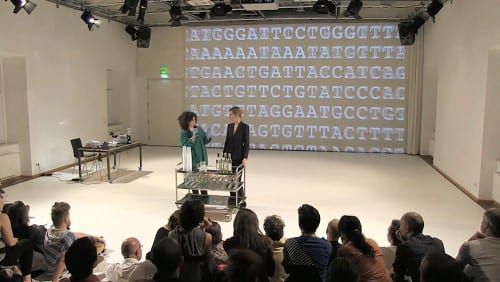
Wetware: Art, Agency, Animation at the Beall Center for Art + Technology, University of California, Irvine, February 6–May 7, 2016
The daring neologism “wetware” proved to be the most apposite term to coalesce the intermedia work of nine international artists affiliated with bioart into one exhibition. Bioart is the field of creative expression in which artists use living matter – cells, bacteria, embryos, plants, flesh, and more – to make works of art, installations, and performances. Like the art it described at the Beall Center for Art + Technology at the University of California, Irvine, the word “wetware” is at once specific and suggestive, capacious while difficult to pin down. Not to be confused with hardware, software, or meatware—the last being its closest variant—wetware names the interface between the biological and mechanical that makes uneasy, blurry distinctions between the living and nonliving, the natural and artificial, and the animate and inanimate. The fluidity of this crossing point lies at the center of Wetware: Art, Agency, Animation, an exhibition cocurated by Jens Hauser and David Familian, with work by Adam Brown, Gilberto Esparza, Thomas Feuerstein, Klaus Spiess and Lucie Strecker, Orkan Telhan, Evelina Domnitch and Dmitry Gelfand, and Anna Dumitriu. Similar to “biomediality,” Hauser’s word for the convergence of “hard, soft, and wetware,” the exhibition was motivated by the merging of fields, epistemologies, and materials.1 The greater field of biology within art is based on a fusion of many fields, the most central of which are art, architecture, design, synthetic biology, genetics, and biocomputation.
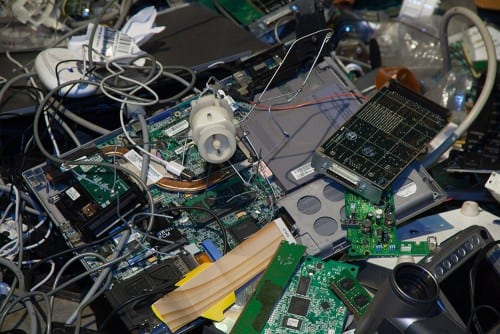
The concept of wetware is not just about machines, but an everyday life molded and manipulated by science as an industrial complex. Wetware circulates widely through epigenetic passageways in and beyond our bodies. It is in our homes through mass-market Direct-to-Consumer Genetic products, in our food through Big Agriculture’s use of antibiotics in animal feed, and in our environment writ large through mammalian waste effluence that is collectively permeated by a gamut of drugs, from the antibacterial to psychotropic. “With the advent of disciplines such as synthetic biology… ‘meaty’ and ‘wet’ living machines…may largely reproduce, proliferate, and become pervasive, while being hardly identifiable,” explains Hauser.2 In this context, “wetware… can mean protocols and devices used in molecular biology and synthetic biology. It encompasses the biological and systems theoretical understanding of life and disrupts the border between organisms and machines.”3 While it is everywhere, wetware can feel like it is nowhere not only because of its constructed and staged naturalism, but also because of the ambiguity which reigns from it. It is one of several forces destabilizing the definition of “life” within the natural sciences, connected to the field of synthetic biology and the miraculous gene-editing tool CRISPR.4
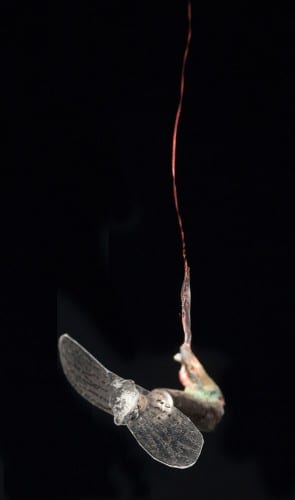
According to the Oxford English Dictionary, “wetware” first appeared in 1975 in the journal Nature to distinguish an electronic computer made up of “hard and software” from a “chemical automaton” which “needs an additional component, a chemical reaction system which might be called ‘wetware.’”5 Rudy Rucker published Wetware in 1988, a science fiction thriller about “meatbops,” a new life form based on the fusion of robots, software codes, and “DNA wetware.”6 While newly created, it is still a term with historicity—Hauser claims wetware is the most recent incarnation of “the historical fascination with staging aliveness,” which “permeates cultural history” in the form of “anthropomorphic statues and pneumatic figures.”7 Writing in 2002, Jessica Riskin situated the term within this history, focusing in particular on examples of “eighteenth-century wetware,” such as Pierre Jacquet-Droz and Jacques de Vaucanson’s automata.8 With the normativity of algorithms, computers, and digital technology, the term has become common in the new millennium. Theorist Richard Doyle cast it in the plural with the 2003 publication of Wetwares: Experiments in Postvital Living. Here, wetware is not just a thing but field of possibilities: a set of “familiars—a zone of interactivity between humans and animals…that blur the contours of human subjectivity,” while, “supplement[ing] [William] Burroughs’s analysis of weapons and their ecologies.”9 Neuroscientist Dennis Bray underscored the computational nature of cell function in the 2009 book Wetware: A Computer in Every Living Cell. Bray elides computer into biological function by way of shared temporality, explaining wetware as the “short-term memory” of bacteria “that tells them whether conditions are better at this instant of time than a few seconds ago.”10
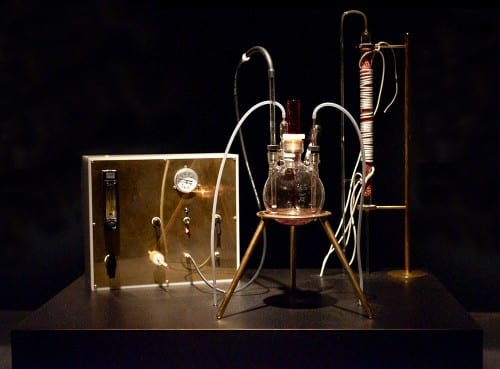
Camouflaged by both the seamlessness and user-friendly nature of biotechnology today, wetware is everywhere. The bio-performance art of Klaus Spiess and Lucie Strecker pivots on the hidden-in-plain-sight omnipresence of wetware. Installed in the exhibition as a single-channel video, Spit Party is a genetic performance project in which the two act out with an audience the process of home genetic testing known as “direct-to-consumer genetics” or DCG. The duo espouses “free speech and free spit,” inspiring interest in the audience to make their genetic information public as visual information. They distribute tubes and informed consent forms, asking for permission to harvest individual saliva samples, which are then visualized as large images of DNA bands. Participants are encouraged to interact with projected DNA images.
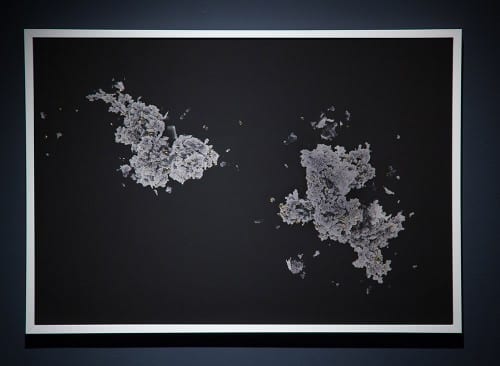
Anthropologist of science Stefan Helmreich, whose thinking influenced the curators of Wetware, demarcates the ambiguous space of life with “limit biologies.”11 Limit biologies set in relief life in the extreme. They embody “a worry about ends” and an “argument from the future,” which above all else “point to larger instabilities in concepts of nature—organic, earthly, cosmic.”12 Helmreich’s three examples of limit biologies—artificial life, oceanic extremophiles, and astrobiology—inscribe the thresholds of biological life shaping the exhibition Wetware. Gilberto Esparza’s work approximates Helmreich’s artificial life while bearing the mechanical trappings of artificial intelligence. Esparza’s Pepenadores (Gleaners), made from recycled motors of toys, crawl amid mechanical detritus, while Moscas (Flies), mechanical insects made from discarded cell phone vibrators attached to invisible metal lines, zigzag above and around viewers’ heads. Adam Brown’s work catalyzes marine bacteria to create a natural element, deploying marine extremophiles—deep-sea bacterial life that defies all odds by living in hypersaline habitats, high pressures, and extreme temperatures. Brown’s The Great Work of the Metal Lover is an alchemical machine hosting the metallotolerant extremophilic bacterium Cupriavidus metallidurans that, under the engineered atmosphere created in the gallery, produces gold. Evelina Domnitch and Dmitry Gelfand’s Luminiferous Drift delves into astrobiology to ponder the signature of life as extraterrestrial. The viewer walks into a dark room cordoned off by black curtains and looks over a small whirling, circular bath of water in which primordial cellular conditions have been recreated. From nano- to meso-, the scales of life overlap and fuse. While the living matter within the works is often invisible to the bare eye, the works themselves—given full shape by various armatures, frames, podia, and mechanical contraptions—are at the scale of mid-size sculptures.
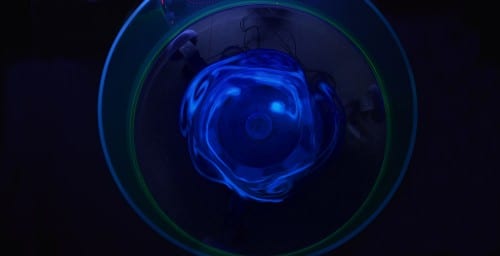
The exhibition destabilizes scientific definitions of life in order to disfigure and decenter anthropocentrism across fields. It is one of several recent bioart exhibitions with this motivation. Emergent Ecologies, curated by Eben Kirskey and a “swarm” of other curators, was an exhibition held in spring 2016 featuring almost 100 artists that took place at Kilroy Metal Ceiling, a large, makeshift space in Brooklyn.13 The exhibition focused on emergent forms of life that are deleterious and beneficial, and how diseases as well as new forms of post-volcanic life subvert “dominant political strategies, economic systems, or agricultural practices.”14 Two exhibitions, Mind the Gut—forthcoming at the Medical Museion in Copenhagen, Denmark15 —and Gut Instinct: Art, Design, and the Microbiome—an online exhibition sponsored by the SciArt Center of New York—focus on gut bacteria, the microbiome, the gut-brain axis, and how putative mind is organismal and extends beyond the brain across the body.16
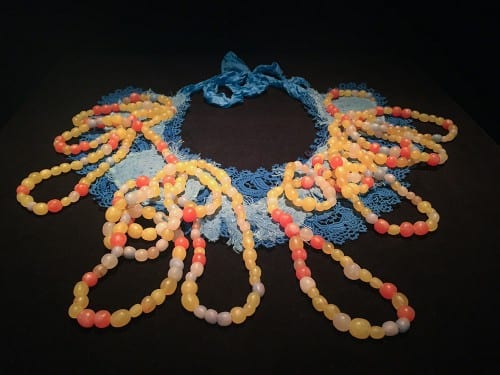
The work in Wetware bears the intellectual and material challenges of high conceptualism and new media art. The work demands much scientific and technological knowledge on the part of its viewers, and an openness to the idea that machines and biotechnological effects (lab work involving enzymes, viruses, and genetic information) constitute a form of art. It would be remiss to understand Anna Dumitriu’s three projects in the exhibition—Engineered Antibody, Necklace, and Faster Mutation—solely in terms of how they look according to the leitmotifs of femininity and traditional women’s work. They are also fundamentally about her collaboration with scientists, a result of her residency working with researchers in the Liu Lab for Synthetic Evolution at the University of California, Irvine. Dumitriu’s Engineered Antibody looks like a colorful strand of beads atop a filigree of blue lace. Its deeper meaning is woven into what it is: a necklace made up of 452 handmade beads containing the actual twenty-one amino acids of an antibody purified from the blood of an HIV positive patient. Living matter connects to language in that their biological stuff is connected to the metaphor that amino acids are the “beads of life”—the idea that scientists enlist to describe structures of proteins constructed from chains of amino acids.
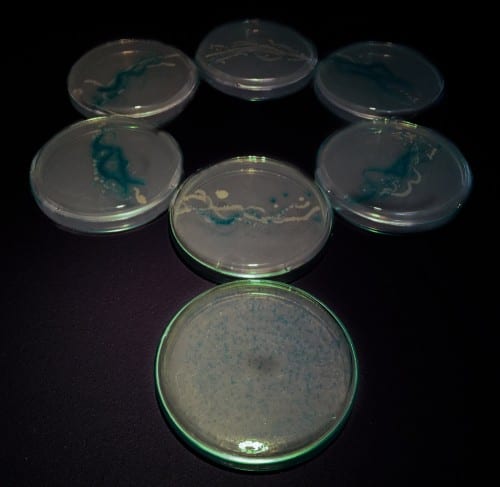
For most viewers, a full understanding of this work would require long, explanatory exhibition plaques (which were happily absent at the Beall), a lot of background reading, and an interview with the artist. Given that none of these things were readily available, Dumitriu’s work and the exhibition overall might seem opaque, intransigent, and frustrating. For many viewers this kind of difficulty—what Theodor Adorno called a “negative dialectic”—is the quintessence of true art. It constitutes a mode of resistance that is political in its refusal to be easily consumed, exchanged within the marketplace, and co-opted by bourgeois norms of taste and beauty. While the bioart of Wetware depends on the ongoing innovation of science within a free market, it does not heedlessly condone that industry or market. Rather, it evaluates and interrogates these systems, which are imbedded in other systems, combining scientific methodologies with the tools of abstract thinking inherent to art. It creates an instance of what I have elsewhere identified as the “Bildung of bioart”— the formation, culture, maturation, up-building, and education of bioart.17
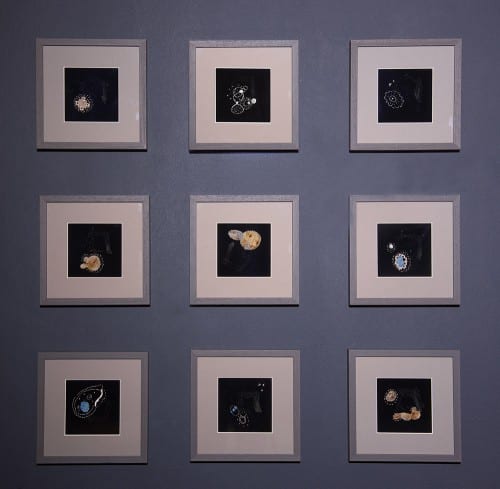

That said, the exhibition fortunately did not sacrifice aesthetic form and matter for an ethics of iconoclasm rooted in biotechnology. There were plenty of art cues in the form of shapes, sounds, and materials. Installers carefully positioned works on pedestals, scrupulously choreographed spaces, smartly painted the walls dark grey, and judiciously orchestrated lighting in the large exhibition space of the Beall. Aesthetics occupied a unique position here for, while the show was not concerned with connoisseurship or the classical delectation of beautiful objects, there was an intended and staged aesthesis—a bodily recognition of form and ideas—present throughout the entire exhibition space. Each work triggered the deep-felt frisson that comes with the “aha” of new knowledge, scientific literacy, and making connections between art, science, and their shared history. This genre of work catalyzes the awe and wonder that comes with recognition of biological complexity that few other forms of art can.
Charissa Terranova is associate professor of aesthetic studies at the University of Texas at Dallas, author of Art as Organism: Biology and the Evolution of the Digital Image (2016) and Automotive Prosthetic: Technological Mediation and the Car in Conceptual Art (2014), and coeditor (with Meredith Tromble) of The Routledge Companion to Biology in Art and Architecture (2016). She is the inaugural director and curator of Centraltrak: The UT Dallas Artists Residency, and regularly curates and writes art criticism. With Davidson College Professor of Biology Dave Wessner, in February 2016 she cocurated Gut Instinct: Art, Design, and the Microbiome, an online exhibition about art, the gut-brain axis, and gastrointestinal microbiome. In the fall of 2015 at Gray Matters Gallery in Dallas, Texas Terranova curated Chirality: Defiant Mirror Images, an exhibition about art and the scientific concept of “chirality,” or non-superimposable mirror images.
- Jens Hauser, “Hard Scrap, Soft Politics, and Wet Machines: Toward an Unnecessary Human,” Cultivos, ed. Gilberto Esparza (Mexico Distrito Federal: Consejo Nacional para la Cultura y las Artes, 2015), 337. ↩
- Hauser, “It’s Time for a Wetware Update,” 1. ↩
- Ibid. ↩
- Heidi Ledford, “CRISPR: Gene Editing Is Just Beginning,” Nature News, 531, no. 7593 (2016): 156–159. ↩
- “Wetware” in Oxford English Dictionary Online, as of May 13, 2016. ↩
- Rudy Rucker, Wetware (New York: Avon Books, 1988), 4. ↩
- Jens Hauser, “It’s Time for a Wetware Update,” WETWARE: Art, Agency, Animation, forthcoming catalogue essay (2016), 1. ↩
- Jessica Riskin, “Eighteenth-Century Wetware,” Representations 83 (Summer 2003): 97–125. ↩
- Richard Doyle, Wetwares: Experiments in Postvital Living (Minneapolis: University of Minnesota Press, 2003), 7. ↩
- Dennis Bray, Wetware: A Computer in Every Living Cell (New Haven: Yale University Press, 2009), 7. ↩
- Stefan Helmreich, Sounding the Limits of Life: Essays in the Anthropology of Biology and Beyond (Princeton, NJ: Princeton University Press), 16. ↩
- Helmreich, 16, and Hauser, “It’s Time for a Wetware Update,” 3. ↩
- Eben Kirskey, Emergent Ecologies, exhibition press release (April 30, 2016). The exhibition was curated by Eben Kirksey, Lissette Olivares, Ellie Irons, Grace Glovier, Cody Kohn, Kayli Marshall, Greg Umali, Alexandra Palocz, Jeffrey Bussolini, and Cheto Castellano,and took place April 30–May 21, 2016. The artists in the exhibition were Maria Aiolova, Marcela Anabalón, Patricia Alvarez, Krisanne Baker, Steve Barrett, Tarsh Bates, Peter Bauer, Vaughn Bell, Karin Bolender, Rogan Brown, Chloe Byrne, Natalia Cabezas and Montserrat Negrete, Corinne Cappelletti, Cheto Castellano, Alonso Cedillo, Sophia Chao, Atom Cianfarani, Tatiana Czekalska and Leszek Golec, Krista Dragomer, J. D. Doria, Anna Dumitriu, Ellen Driscoll, Grayson Earle, Melanie Fessel, Ivan Fuentealba, Regina José Galindo, Mikhail Gervits, Grace Glovier, Yucel Guven, Christian Hamrick, Shandor Hassan, Andrea Haenggi, Elena Tejada Herrera, Kathy High, Jeff Hoelle, Susan Hoenig, Henry Horn, Ellie Irons, Antonia Isaacson, Maca Jimenez, Mitchell Joachim, Sharon Kallis, Anja Kanngieser, Christopher Kennedy, David Khang, Katie King, Eben Kirksey, Kitch, Michael Klingler, Cody Kohn, Miguel Lantigua-Inoa, Lian Lian, Lenore Malen, Matsya, Jane Marsching, Mary Martin, Alex May, Laura McLauchlan, Felipe Molina, Lucia Monge, Sung Moon, Leila Nadir, Eli Neira, NEOZOON, Juan Olivares, Lissette Olivares, Terreform ONE, Alexandra Palocz, Cary Peppermint, Anne Percoco, Eva Perrotta, Angela Petsis, Praba Pilar, Deanna Pindell, Prima and other suspects from the Center for Feline Studies, Danny Reveco Appelger, Peter Richards, Coco Rico, Shark Roth, Christy Rupp, Robyn Shapiro, Sin Kabeza Production, Annie Sprinkle + Beth Stephens, Polly Stanton, Anna-Sophie Springer and Etienne Turpin, Karolina Sobecka, Andi Sutton, Matthew Tarpley, The Natural History Museum (Not an Alternative), Anaïs Tondeur and Marine Legrand, Vandra Thorburn, Marlene Tseng Yu, Greg Umali, Anuj Vaidya, Kamila Varela, Vesper, Artemisia vulgaris, Ruth Wallen, Maria Whiteman, Amanda Yates, JiaChen Xu, and Adam Zaretsky. ↩
- Ibid. ↩
- See http://www.museion.ku.dk/mindthegut/, as of May 9, 2016 ↩
- See http://www.sciartcenter.org/gut-instinct.html, as of May 9, 2016. This exhibition marked the culmination of a virtual residency, September 2015–February 2016, conducted through the SciArt Center New York between the author and David Wessner, Professor of Biology at Davidson College. The exhibition includes artwork by artists Anna Dumitriu, Kathy High, Rachel Mayeri, Ken Rindaldo, Meredith Tromble, and Adam Zaretsky and by scientists Mehmet Candas and François-Joseph Lapointe. ↩
- Charissa N. Terranova, “Bioart and Bildung,” forthcoming in the Journal of Microbiology & Biology Education, fall 2016 ↩

